Despite the Dangers, the Cloud is the Way Business is Done

Storage in the cloud must have been one of the most brilliant marketing ploys ever.
Cloud computing/storage was first discussed 20-plus years ago (1996 to be exact) by brilliant techies at Compaq (gobbled up long ago by HP) who could see into the future and thought, “Crap, this might eat into our biz sales, so we better get ahead of it.”
It took another 10 years for the idea to catch on when then Google CEO Eric Schmidt at the Search Engine Strategies Conference got all fired up about the cloud idea because it looked like a bunch of services they could sell instead of relying solely on ad and personal data sales.
It turns out he was right. According to Gartner, cloud services will surpass $206 B this year.
And as TECHnalysis Research recently reported – highlights are here – it comes in several flavors: public, private, hybrid.
That’s a serious expense and choice for individuals, companies and governments around the globe.

But according to network security firm Lastline, 50 percent of non-IT people honestly believe the cloud is literally … in the sky.
Seriously?
Wonder if they worry about getting hit by a system when it crashes or getting drenched in data when there’s a hack?
Hate to burst your bubble but the cloud you compute in or store your stuff in is in one or more big data centers located across the country or around the globe.

That’s right, instead of something soft, fluffy and dreamy; cloud facilities are big nondescript buildings housing row upon row of servers and rack after rack of hard drives and flash memory.
To be ultra-clear about the cloud, read Kitty Flanagan’s explanation—the best we’ve ever heard – https://tinyurl.com/y7hy4fq5.
Despite that, Microsoft, Amazon, Alphabet, Alibaba, IBM and others have consistently reported enviable growth in the sales of their cloud services.

In fact, business is so good they can’t build new facilities fast enough. Google recently announced they would be investing $670M in a new data center in Finland on top of the more than $4.3B they’ve invested in European data centers since 2007.
Google has 58 data centers worldwide and the other computing/storage service providers are expanding just as rapidly to keep up with business, governmental and individual customer requirements.
Cloud computing/storage continues to grow despite the fact that server-huggers argue that their workloads don’t belong in the public cloud because of security, performance and similar issues. They feel they can run their infrastructure more efficiently, save money for the company and keep their data safer than in a public cloud.
NOTE: We aren’t champions of cloud storage except as a backup to a backup to a backup, but still…
The ugly fact is that these organizations can buy hundreds, thousands of servers more economically than 90-plus percent of organizations can. They have huge teams of experts who can optimize their utilization, operate and support specialized apps, and have a large number of seriously trained AI and security technicians.

The bottom line is that there is no way a firm can keep up with the specialties needed and the rapidly changing digital environment.
To stay ahead of their competition, they invest heavily in R&D efforts that include a broad range of open source and advanced projects that can drive automation scale and improve processes. It enables cloud firms to attract and retain talented people who are interested in conquering difficult technical challenges.
This translates into more and better hardware, software and people.

The US continues to be home to more than 40 percent of the world’s major cloud data centers
but folks are expanding their processing/storage network. Because of the EU’s GDPR (General Data Protection Regulation) and other local/national concerns over personal/corporate data privacy, everyone is focused on regulatory compliance.
To provide business readiness; Google, Amazon, Microsoft, IBM and other major cloud providers are building new data centers that are being built in Germany, UK, Singapore, Australia, Brazil and other countries around the globe. Not unsurprising, China’s Tencent and Baidu as well as other firms are expanding their data centers.

At the expense of higher profits, the cloud service firms are aggressively investing in cloud and compliance engineering, capacity, application development as well as advanced AI tools and services for themselves and their clients.
Businesses increasingly want to/need to know where their data is stored and what is going on with it to ensure their corner of the online world is more secure and they avoid abusive data practices and governmental fines.
Ignoring compliance or non-compliance is a risky strategy.

And right behind privacy compliance (a major concern for every organization – large and small) is aggressive, robust security.
This becomes increasingly important as telecom providers build out their local, national and international 5G communications capabilities.
Looking to provide ultra-high-speed connections between data centers and their customers, telecom providers including AT&T, Verizon, CenturyLink, BT and others around the globe have sold off their data center operations.
This will enable them to focus on delivering the next network speed jump from 100 – 400 Gbps to win more business from large enterprise customers, cloud providers and content owners/distributors.
Back in the cloud’s infancy, IT and senior corporate management were afraid – rightfully – of being locked-in to a specific service provider. But today, software is is being offered “as-a-service” so firms/individuals can run their applications on top of the services and move from one provider to another if it becomes absolutely necessary.
Speed and access to innovation are far more important to management rather than their ability to move if it becomes necessary.
The biggest misconception with management and individual users is that moving your work and workloads to the cloud automatically makes them more secure.
It’s better but it doesn’t/shouldn’t eliminate security concerns.

According to a report from cybersecurity firm McAfee at this year’s RSA Security conference, eighty-three percent or firms studied store sensitive data in the cloud but only 69 percent trust the public cloud to keep their data secure.
Unfortunately, the popularity and demonstrated security competence of cloud service providers doesn’t mean companies and their security team can turn the responsibility to mange cloud security to the service provider.
Last year, businesses in the US lost $2.7 B through data breaches and on a global scale, those losses were as much as $600 B.
Most IT folks cite the lack of adequate funding as the reason they’re unable to provide robust security for their organization, most of the breaches could be prevented by continually training and reminding staff members that employees typically open the door for data theft.

Working in the cloud has become normal for everyone. So much so that security firms note that people don’t think twice about sharing/storing sensitive data in the cloud, resulting in an increase of 53 percent year-over-year.
This has become standard in the M&E industry where RAW content is often sent directly to the cloud, worked on by team members in widely dispersed locations and ultimately distributed OTT to individual’s screens.
Cloud collaboration has made it fast and easy to share video segments/documents with just a few clicks.
Accidental sharing, collaboration and configuration errors, compromised accounts and insider threats have increased so rapidly that McAfee estimates that 92 percent of organization have their stolen cloud credentials available for sale on the dark web.
Cybersecurity firm Kaspersky said that to protect their information in the cloud the first thing they must do is raise awareness among their employees about the dangers of opening or downloading certain files (If we have to explain them, shut off your device!).
They should also make departments and team members fully aware of the dangers of circumventing IT policies and using cloud services without notifying them.
In a cross-industry study, Blue Coat Systems found that organizations’ departments and personnel are running 20 times more cloud apps than they estimate, with most using an average of 841 across their extended networks
According to IDC, nine-in-ten SMBs (88 percent) and enterprises (91 percent) have experienced a data breach affecting their public cloud infrastructure. The top three types of data stolen were: information that confirms customer identity, customer payment information and user authentication credentials.
In addition to a damaged reputation, the average cyberattack costs SMBs $206,000 and losses to large firms averaged about $2M.
 Despite the concerns, few firms have security programs tailored to their business.
Despite the concerns, few firms have security programs tailored to their business.
While they’re vulnerable to attacks, they plunge ahead even as Tom warns them, “That’s something you can’t unsee.
# # #
Andy Marken – [email protected] – is an author of more than 600 articles on management, marketing, communications, industry trends in media & entertainment, consumer electronics, software and applications. Internationally recognized marketing/communications consultant with a broad range of technical and industry expertise especially in storage, storage management and film/video production fields. Extended range of relationships with business, industry trade press, online media and industry analysts/consultants.